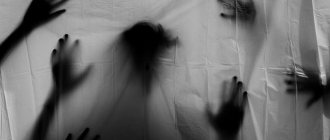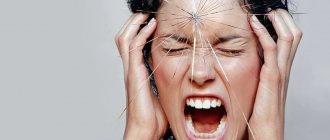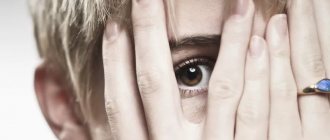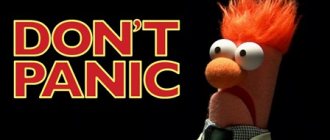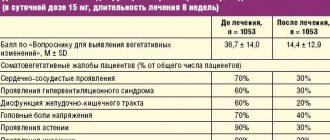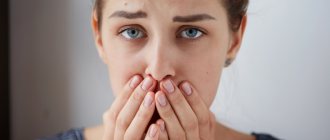Category: »» Diseases requiring complex treatment
Dubovskaya Nadezhda Alexandrovna
Chief physician of the Clinic, neurologist
Author of the article
Your palms become moist and your heart rate increases, but there seems to be no reason for such symptoms? Such signals are given by the brain when a panic attack “approaches”. For this pathology, psycho-emotional factors of occurrence are not necessary; it is enough for osteochondrosis to begin to progress in the cervical spine.
“Physiological” or “mental” depression: how to determine the cause of the disease
The first thing to remember is that panic attacks do not appear out of the blue; there is always a reason for their “awakening”. If a person does not have an innate predisposition to a depressive state, there have been no significant events in life that “knocked him out of the rut”, in 90% of cases we are talking about problems with the physical state of vital systems - cardiovascular and circulatory. The cause of uncontrollable panic and reluctance to enjoy life in the case of osteochondrosis is degeneration of vertebral cartilage in one form or another, which leads to disruption of the functioning of surrounding nerve roots and blood vessels. The resulting protrusions, hernias or other damage to the intervertebral disc lead to compression of the vessels providing blood supply to the brain. In 60% of cases, “advanced” osteochondrosis leads to oxygen starvation of the brain. Trying to normalize its condition, the “main organ” gives alarming signals, including those of a psychological nature.
How does Afobazol work?
The drug is classified as a tranquilizer, but it should be noted that it stands out compared to its other counterparts.
Most members of this group act on benzodiazepine receptors. In this regard, there are some side effects of such drugs, such as: drowsiness, muscle atony, decreased concentration. Cases of addiction and withdrawal syndrome are common. But Afobazol acts very gently, bypassing all of the above complications. It has no effect on benzodiazepine receptors, acting directly on GABA-sensitive neurons and increasing their sensitivity.
GABA (gamma-aminobutyric acid) suppresses increased nervous excitability of the brain. This is the leading neurotransmitter that is responsible for inhibition processes in the central nervous system. It inhibits the action of acetylcholine and adrenaline, which cause emotional outbursts and pain. But at the same time, GABA activates the energy potential of brain tissue, stimulates blood circulation in it and the absorption of glucose and oxygen by cells, that is, it improves trophism or nutrition of the brain.
Afobazole reduces the activity of subcortical centers, such as the thalamus or hypothalamus, which are responsible for human emotions.
By taking Afobazole, you will protect your nervous system without falling into a stupor.
How to determine that the pathology is caused by osteochondrosis
The following symptoms are typical for panic attacks and depression:
• spontaneity. Anxiety may appear for no apparent reason;
• changes in character: increased aggressiveness or “tearfulness” in a balanced patient, apathy in an active patient, reluctance in sexual intimacy in a loving one;
• feeling of lack of air. Thus, the brain sends a signal about a lack of oxygen to the respiratory organs.
• sleep and appetite disturbances. Anxiety symptoms affect the nervous system. The desire to eat normally disappears, night rest becomes restless, and dreams become chaotic, often nightmarish.
If such symptoms are caused by osteochondrosis, then usually a person can also feel the following “bonuses”: dizziness, sudden changes in pressure (dystonia), headache, periodic numbness of the limbs and facial muscles, hearing and vision impairment.
If at least 2 of the above symptoms coincide, you will not be able to cope with depression and panic attacks on your own. A doctor's help is needed.
More about vegetative-vascular dystonia
This is a syndrome accompanied by disruption of the autonomic nervous system and functional failures of many organs. Vegetative-vascular dystonia is not a separate disease, but is considered a complex of symptoms of various etiologies.
A similar condition was first described in 1918 in America by the doctor B. Oppenheimer, who called it “neurocirculatory asthenia.” In Soviet times, the syndrome was called vegetative-vascular dystonia.
In the modern world, its manifestations are united under the name “neurocirculatory dystonia”. According to the ICD-10 classification, this is expressed by the concept of “somatoform dysfunction of the autonomic nervous system.”
Symptoms of this condition are quite varied:
- pain in the heart area, palpitations;
- breathing disorders in the form of shortness of breath or suffocation, lack of air;
- constant headaches, dizziness;
- poor sleep;
- pain in joints, muscles;
- fatigue, weakness, malaise, loss of consciousness;
- convulsive twitching of arms and legs, tremors;
- violation of thermoregulation;
- low-grade fever up to 37°;
- increased sweating, sensations of heat, dry mouth.
Of course, such manifestations of VSD can have real causes: chronic infections, intoxication, hypoxia, prenatal and postnatal lesions, osteochondrosis of the cervical spine with impaired blood supply to the brain.
But most often such symptoms become a manifestation of neuropsychic disorders: hysteria, suspiciousness, increased impressionability, nervous exhaustion.
This is also facilitated by various kinds of events that cause emotional stress and throw the nervous system out of balance. In this case, a number of symptoms are joined by others that indicate mental imbalance:
- sense of anxiety;
- obsessive thoughts and phobias;
- fear of death;
- feeling like you're going crazy;
- disbelief in the reality of what is happening.
Rather, it is nervous disorders that cause painful and unpleasant sensations in other organs. This fact is confirmed by the fact that during the examination, organic disorders in the declared organ are not recorded.
In situations where nervous tension goes beyond acceptable limits and mental state is disturbed, Afobazol will help. The drug is an anxiolytic, that is, it has
ability to eliminate anxiety. Along with it, irritability, excessive concern and groundless fears go away.
Relieving nervous tension, the drug helps to relax, reduce anxiety and improve sleep, and eliminates obsessive fears. With the normalization of the nervous system, symptoms of dysfunction of internal organs disappear. In addition, cognitive functions improve: memory and concentration.
How can a specialist help with depression?
Depression, especially spontaneous depression, is not a reason to make an appointment with a psychiatrist. Start with something simple - a visit to a therapist. A thorough visual inspection will tell a good specialist a lot. The doctor’s goal is to make a correct diagnosis, on which 90% of the effectiveness of treatment depends. If there is a suspicion of osteochondrosis and the symptoms are associated specifically with this pathology, a laboratory study of blood biochemistry and ultrasound of the vessels of the cervical spine are recommended. After studying the results, it will be possible to decide what caused the panic attack and depression. Treatment is prescribed in accordance with the physical and psychological condition of the patient and is carried out comprehensively. The goal is to simultaneously normalize blood flow in narrowed vessels and relieve a person from emotional exhaustion. Therapeutic measures can be different: taking medications to improve brain function, physiotherapy, prescribing sedatives or antidepressants.
Categories
There are two types of classifications of PA (panic attacks). For reasons of occurrence:
- situational. The feeling of horror, as well as other symptoms, appear only in a certain situation, which has a negative impact on the person and his body as a whole;
- spontaneous. Can occur at any time, regardless of place, time or emotional state at the current moment;
- conditional-situational. It only appears when exposed to chemicals. For example, alcohol or tobacco.
By VSD type:
- hypotonic type. It is characterized by sweating, decreased blood pressure, shortness of breath, nausea and body weakness;
- hypertensive. In this type, the most common symptoms are rapid heartbeat, rapid pulse and increased blood pressure;
- mixed. The patient experiences two types of panic attacks at once during VSD.
Independent actions
In order not to “start” the disease and not get a chronic form of depression, preventive measures are necessary. Walking in the fresh air, physical exercise, giving up bad habits and even a simple change of pillow will help you regain the joy of life faster. As for the emotional state, it is better to be guided by your own interests. You can get rid of apathy by leading an active lifestyle - communicating with friends, going to the cinema, theater, and exhibitions. If a person is a homebody by nature and going outside is a feat for him, then first ensure that the rooms are well ventilated and have sufficient physical activity; this is easy to do at home. Remember, the sooner you start fighting the disease, the higher the effectiveness of treatment.
In this article we tried to answer your questions:
- How to recognize depression in osteochondrosis?
- How to treat depression with osteochondrosis?
- Can depression be treated with medication?
- Which doctor should I go to for depression?
What to do in case of a panic attack
The most important thing to do during a panic attack is to switch your attention. Any method is suitable for distraction. If an attack occurs in a public place, you can clench and unclench your fists, rub your earlobes, or shift from foot to foot. If panic takes you by surprise at home, try turning on music and starting to do household chores: washing dishes, dusting. Any activity that involves muscle work and requires attention is suitable.
Since a panic attack is accompanied by a rapid heartbeat and a feeling of stuffiness, it would be a good idea to take a couple of sips of water and concentrate on breathing. It is best to master several techniques that will quickly relieve tension. In case of an attack, start by exhaling - slow it down, and the pulse will also slow down. The ratio of the length of inhalation and exhalation should be 1:2. You can experiment and choose the technique that will help you. A smartphone can also help you take your mind off panic. Games, social networks - all this will shift attention and distract from a panic attack.
Breathing exercises and meditations
Yoga is a very powerful ally in the fight against panic attacks. More precisely, its two main components: breathing practices and meditation.
Under Meditation
In yoga they understand a special technique of deep relaxation. During meditation, we completely disconnect from the outside world, concentrating on internal sensations and creating a kind of protective barrier. In addition to complete relaxation, it helps fight stress, control your fears and strengthen the nervous system. This is exactly what we strive for! It is not for nothing that meditation is recommended by psychotherapists and neurologists for many types of deviations.
Regarding breathing exercises
, then they are especially effective directly during an attack. Try to concentrate on your breathing, stabilize it and make it as deep and measured as possible. Use the so-called diaphragmatic breathing: draw as much air as possible into the abdominal cavity (“breathe from the stomach”), not from the chest. Meditation and breathing exercises work very well together.
In conclusion, we emphasize: all the methods we have listed do not work on their own, but in combination. Try to apply them systematically and avoid chaos in your daily routine. This is how confidence and calm will return to you, additional strength will appear that will help you overcome not only panic attacks, but also many other side problems and deviations.
Treatment of panic disorder
Antidepressants and tranquilizers are widely used as medications in treatment. Psychotherapy is a successfully used method of treating panic disorder, in particular, cognitive behavioral therapy: psychoanalysis, which helps to become aware of repressed psychological stimuli; special programs aimed at eliminating anxious thoughts of an obsessive nature, such as the “thought stopping method”.
The disease has its peaks and valleys, many patients recover almost completely, while others continue to have recurrent symptoms. With adequate treatment, patients can sufficiently adapt to social life.
